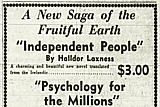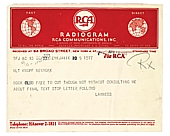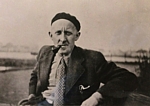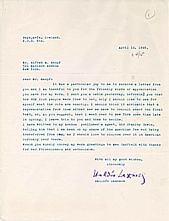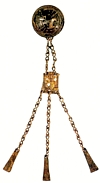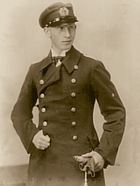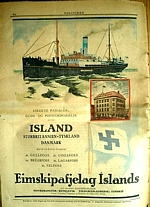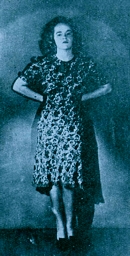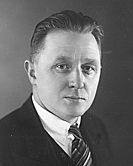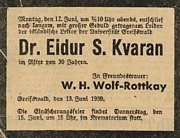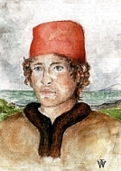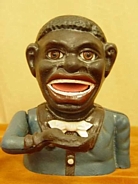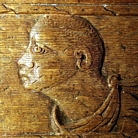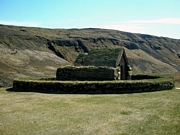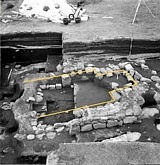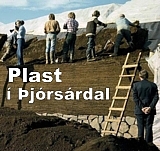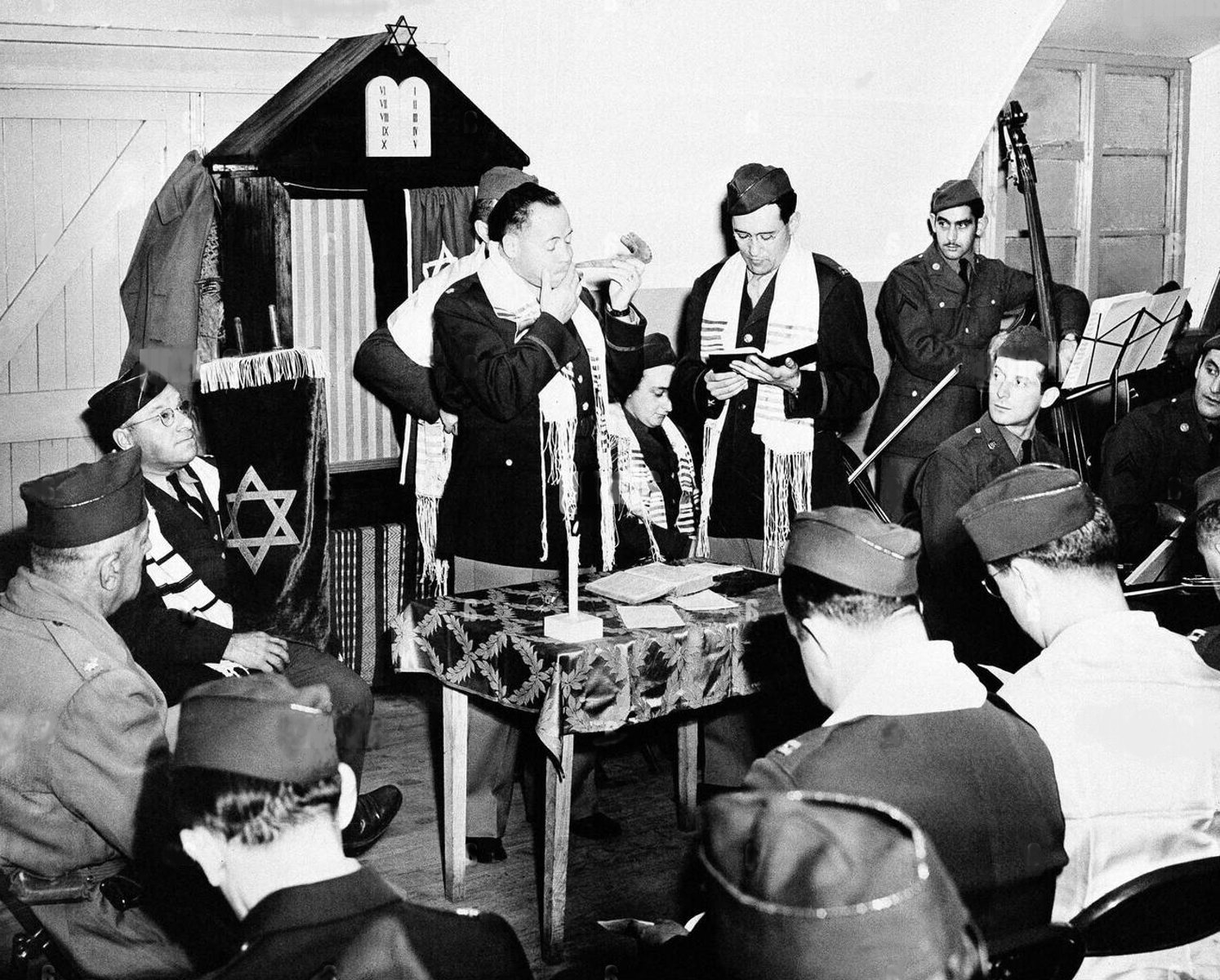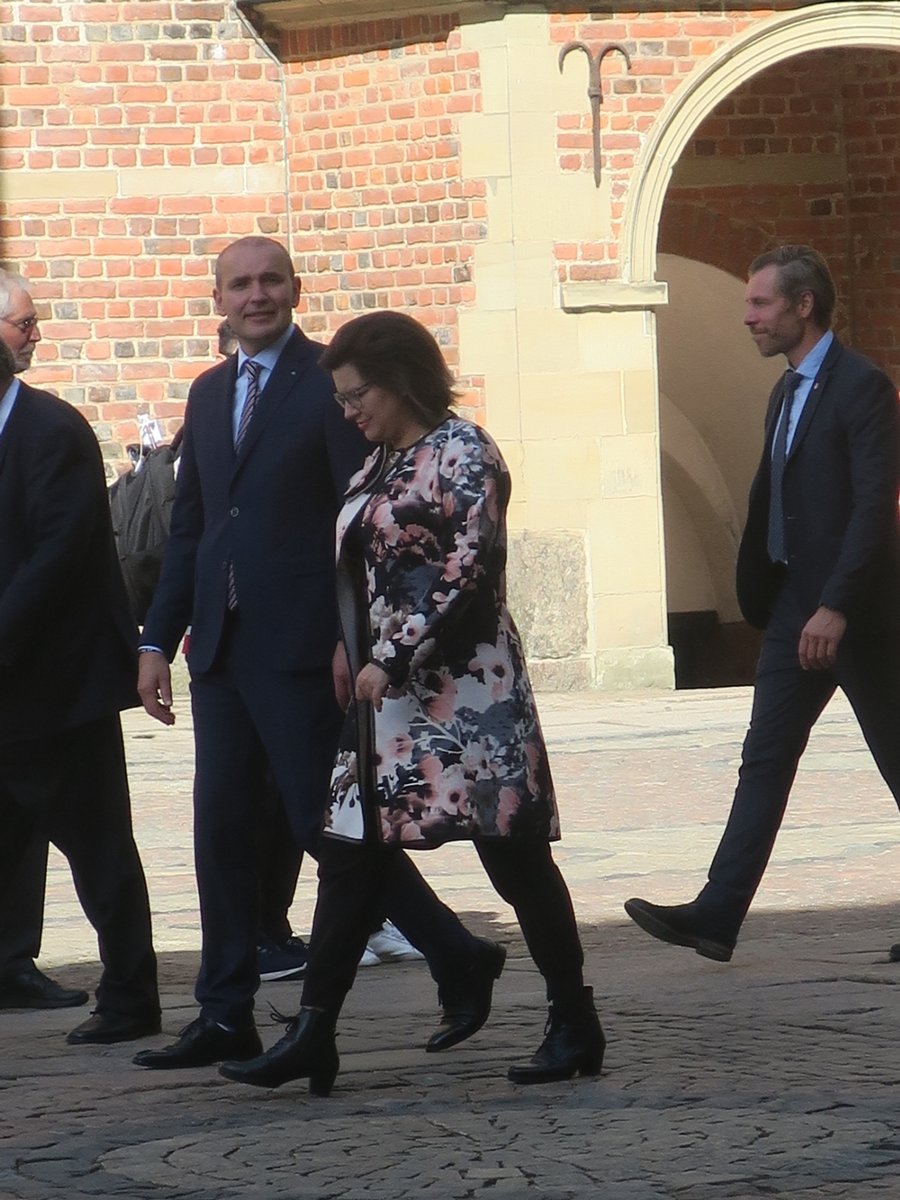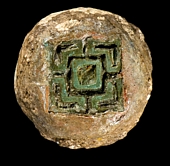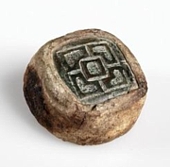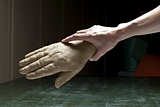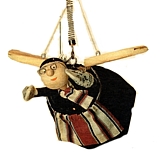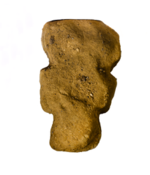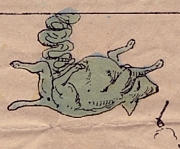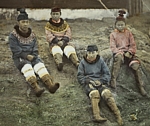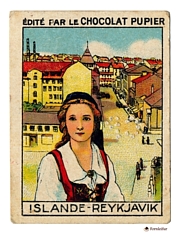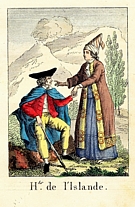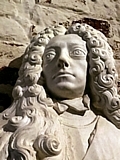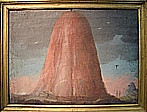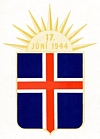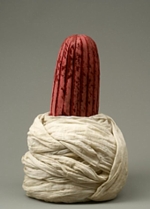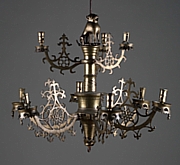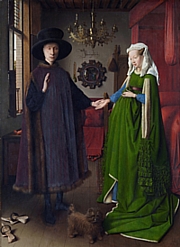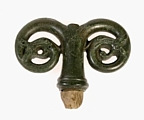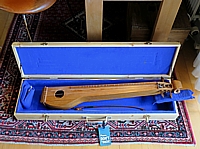Bloggfćrslur mánađarins, september 2022
Julius A. Leibert, the first Rabbi in Iceland
27.9.2022 | 06:51
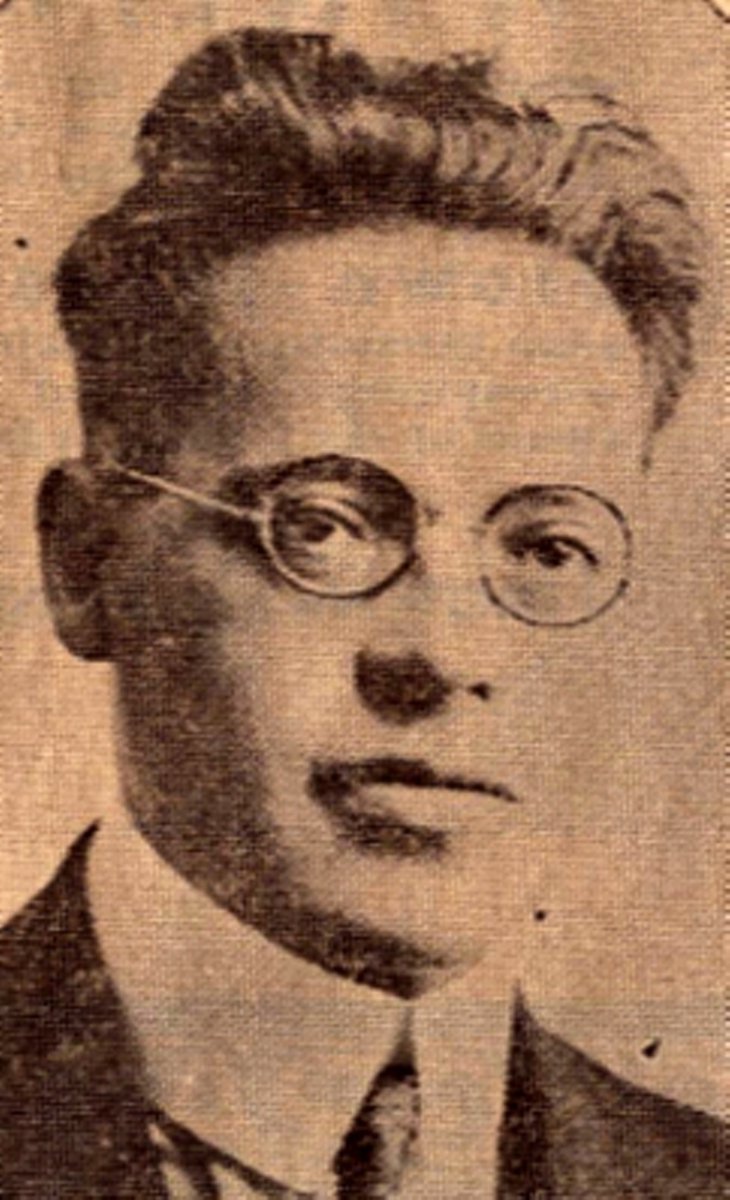














Please DO NOT use my articles without a proper references.
Bloggar | Breytt 4.12.2023 kl. 22:50 | Slóđ | Facebook | Athugasemdir (0)
Hnífur Gilsbakkaprests
21.9.2022 | 07:51
Hinn ágćti Íslandsvenur, bandaríski fornleifafrćđingurinn dr. Kevin Smith, heldur úti FB-inni North Atlantic Archaeology. Ţađ er einkar gott framtak hjá dr. Kevin sem hjálpar nefnilega ţeim sem ekki nenna ađ eyđa tíma sínum í ađ leita ađ nýjustu fréttum.
Nú má vart finnast títuprjónn viđ fornleifarannsókn, ađ ekki sé stórfrétt um ţađ í blöđum og öđrum fjölmiđlum. Kevin vinsar ţó ađeins "háu ljósin" sem ritađ er um á ensku, en menn geta líka sjálfir sett inn fréttir á FB-ina North Atlantic Archaeology, ef ţeim er mikiđ mál á ţví. Stór hluti íslenskra fornleifafrćđinga fylgist međ á FB Kevin Smiths, en einnig enn meiri fjöldi leikra sem lćrđra sem hafa áhuga á fornleifafrćđi í löndum viđ Norđuratlantshaf.
Nú fyrir helgina var Smith á faraldsfćti á leiđ til Noregs. Hann sett frétt um forláta hnífsskaft sem fundist hefur í Osló, sem er frá seinni hluta miđalda og hugsanlega er skaftiđ úr fílabeini. Fornleifafrćđingurinn sem stjórnar rannsókninni Osló (sem ćttađur eru úr Niđurlöndum) bendir á, ađ forláta hnífssköft úr fílabeini hafi veri framleidd í Amsterdam og leggur til, ţó án mjög haldbćrra raka ađ skaftiđ í Osló sé ţađan. Hvort skaftiđ er örugglega úr fílstönn hefur ţó ekki veriđ rannsakađ.
Í góđum umrćđum,sem oft skapast neđanmáls á FB-North Atlantic Archaeology, lćkar fólk annađ hvort eđa skrifar bara "wow" og einstaka mađur lćtur ljós sitt skína, sýndi Kevin Smith forláta hnífskaft smellt, vafalaust hollenskt frá 17. öld sem hann og ađstođarfólk hans fundu viđ fornleifarannsóknir á Gilsbakka á Hvítársíđu í Borgarfirđi fyrir u.ţ.b. 14 árum síđan (sjá mynd efst).
Ég kannađist viđ skyldan grip sem fundist hefur í Frakklandi og fann fljótt skýrslu um hann sem ég hafđi hlađiđ niđur á gamalt fornleifadrif Fornleifs.
Fyrir utan sekkjapíparann efst, ef lítill munur á hnífsskaftinu frá Gilsbakka og ţví sem fannst í Loches.
Skaft úr aski Síra Gunnars Pálssonar?
Greinilegt er ađ mjög miklar líkur er a ţví ađ Gilsbakkamenn hafi étiđ vel á 17. öld. Mig grunar hver ţađ var. Dr. Kevin Smith reyndist einnig hafa haft augastađ á sama einstaklingi. Á Gilsbakka bjó m.a. og ţjónađi síra Gunnar Pálsson (1587-1661) sem var í sinni samtíđ lýst sem miklu heljarmenni. Svo mikiđ "hreystimenni", (en ţađ kallađi mađur feita menn á ţeim tíma): Hann var svo líkamsţungur ađ trauđlega báru hann sterkustu hestar. Er ekki ósköp líklegt ađ slíkur jálkur hafi átt forláta hollenskan hníf og jafnvel gaffal, svo hann gat skoriđ svera sneiđ af sođnum sauđ á sunnudegi eftir messu.
Hver segir svo ađ fjasbókin sé til alls ónýt?
Pater fra Loches, og vel í holdum.
Bloggar | Breytt s.d. kl. 08:07 | Slóđ | Facebook | Athugasemdir (1)
Sómi landsins og skjöldur var í Danmörku í dag
12.9.2022 | 14:15
Nú varđ ţađ loks úr, ađ Forseti Íslands fékk skjöld ţann sem hann hefur beđiđ eftir ađ fá síđan hann var sćmdur hinni dönsku Fílaorđu af Margréti Danadrottningu áriđ 2017. Ýmislegt hefur orđiđ til ţess ađ ţađ dróst, m.a. kórónan á okkur öllum og margt annađ. En klukkan 11 í morgun var skjöldurinn afhjúpađur.
Fornleifur er, eins og allir vita, mikill forsetadýrkandi og drottningarsinni, en ađeins ţegar ţćr verur eru viti bornar og mannlegar. Hann skrifađi í leiđindum á Cóvid-tímum um skildi ţá sem íslenskir forsetar höfđu fengiđ í kjölfar ţess ađ á ţá var hengdur danskur albínófíll (Sjá hér og einnig hér). Getgátur Fornleifs í fyrri greininni um skjöld Guđna reyndust ţví miđur ekki réttar.
Fornleifur fyrstur međ fréttirnar
Fornleifur er oft fyrstur međ fréttirnar og sendi í dag ljósmyndara sinn út í kúamykjusveit á Sjálanditil ađ reyna ađ ná mynd af Guđna Forseta og skildinum hans. Ljósmyndadeild Fornleifssafns hefur ráđiđ mjög góđan ljósmyndara, sem líka er ökufantur. Mjög seinn á ferđinni skaust á Skódanum sínum til Friđriksborgarhallar til ađ ná forsetanum og öđrum fyrirmönnum á filmu.
Haukfrán augu forsetans sáu ljósmyndaragarminn á Fornleifi (myndin efst sýnir akkúrat , ţegar Guđni fékk pata af ljósmyndaragarminum). Forsetinn gekk beint til ljósmyndarans og heilsađi á hann međ handabandi sterklegu, og lét ţau orđ falla ađ hann lćsi nú oft Fornleif, en vćri ekki endilega alltaf sammála honum. Ljósmyndarinn varđ hálf munnlama viđ ţann dóm, og vegna skyndilegrar snobblömunar vildi hann hafa sagt ađ Fornleifur vćri nú ekki heldur alltaf sammála ţví sem hann skrifađi sjálfur - en hefđi ţađ samt allt sem réttast.
Fornleifur er heldur ekki alltaf sammála ţví sem forsetinn segir, t.d. nú síđast í lakkríssúkkulađimálinu - svo ţađ kemur út á eitt hvađ forsetanum sýnist.
Ljósmyndagarmurinn er nú ađ koma út úr myrkraherberginu međ ferskar myndir af Guđna og skildinum hans í höllinni.
Á skildinum stendur, DOM: GUĐNI TH. JÓHANNESSON PRAESES REIPUBL: ISLANDIE DIE XXIV JAN: AN: MMXVII eđa Herra Guđni Th. Jóhannesson, forseti lýđveldisins Íslands. Ţann 24. janúar áriđ 2017.
Á borđa yfir opinni bók, sem rauđur Ţórshamar svífur yfir stendur:
TIBI IPSI ESTO FIDELIS
sem eru ađ líkindum Sókratísk ummćli, og má ţýđa yfir á íslensku á ţennan hátt: Vertu sjálfum ţér trúr (eđa samkvćmur), sem er líka ágćt íslensk lífsregla.
Ţórshamarinn yfir bókinni er svo líklega tilvísun í sagnfrćđina eđa Thorlacius nafniđ. Ađ hamarinn er rauđur, skal látiđ ótúlkađ hér á Moggabloggi.
Á neđra helmingi skjaldarins er silfrađ haf, vćntanlega Atlantsálarnir og í ţví birtist kanadíska Hlynslaufiđ rauđa, og vísar ţađ vafalaust til Alizu konu Guđna, sem hann sótti sér og ţjóđinni, til heilla yfir álana.
Í hinu silfrađa hafi dóla líka 5 lítil akkeri og ţar eru ugglaust komin börn ţeirra hjóna, sem eru fimm ađ tölu. Svartgljáandi bakgrunnurinn er kannski íslenski lakkrísinn sem Guđna er svo hugleikinn ađ hann berst međ kjafti og klóm fyrir rétti hans á alţjóđavettvangi.
Fornleifur gefur skildinum ágćtis einkunn, ţví hér kemur loks forseti, sem kemur ţví ađ, ađ forsetafrúin (eđa mađurinn) gegnir einnig mikilvćgu hlutverki fyrir embćttiđ: Ber er á baki kvenlaus karl. Ţannig á ţađ ađ vera.
Annađ, sem fréttnćmt mćtti ţykja, er, ađ íslenski sendiherran kom allt, allt, alltof seint í skjaldarafhjúpunina í Friđriksborgarhöll. Ég sem hélt ađ hún ćtti hrađskreiđan sportbíl.
 ... og ađ einhver afgangur varđ af smákökum, snittum og kampavíninu. Hér sjást orđumeistarar eđa starfsmenn Ţjóđsögusafnsins í Friđriksborgarhöll bera fat af kökum og smá kampavínssull frá höllinni. Verđi ţeim líka ađ góđu.
... og ađ einhver afgangur varđ af smákökum, snittum og kampavíninu. Hér sjást orđumeistarar eđa starfsmenn Ţjóđsögusafnsins í Friđriksborgarhöll bera fat af kökum og smá kampavínssull frá höllinni. Verđi ţeim líka ađ góđu.
Bloggar | Breytt s.d. kl. 15:32 | Slóđ | Facebook | Athugasemdir (0)
The Greatest of all Icelandic Inventions - The Chocolate coated Licorice
12.9.2022 | 06:46
Monday, 12 September 2022, the President of the Republic of Iceland will have his very own crest, accompanying the Danish order of the Elephant, revealed at the Chapel of the Palace of Frederiksborg, North of Copenhagen.
The Icelandic President, the honourable Dr. Jóhannesson gets his specially personalized crest as a part of the honour bestowed upon him in 2017, when Danish Queen Margrethe II pinned the Order of the Elephant, the highest of all orders in the Kingdom of Denmark, to the president´s chest.
Everyone, who receives the Order of the Danish Albino Elephant, also receives a personalized crest - among them all heads of states in the Nordic countries, kings, queens and presidents alike. The white Jumbo is simply the Top-Bling of Denmark.
The Elephant-bling on the chest of a man, who once in a while behaves like a clumsy giant elephant in a glass-shop, is actually quite appropriate. Recently, President Guđni Th. Jóhannesson, brought perpetual shame upon the Icelanders, when he praised the presidents and foreign minister from three Baltic States, Estonia, Latvia and Lithuania, when they were on a state visit in Iceland. The governments of these three states have since 1991 been systematically white-washing the numerous local murderers of Jews during WWII, who nowadays are highly praised as freedom-fighters in these new European Union republics. The great-grandfather of the present foreign minsiter of Lithuania was a member of a Nazi collaborator government in 1941, and supervised ghettos and the "Jewish sollution" in Lithuania.
Few weeks later the Icelandic president appeared is in the role of the protector and spokesperson of all sorts of Chocolate-coated licorice, which the President is convinced is a 100% Icelandic invention, possibly predating the voyages of Columbus to the Americas.
Icelandic President: "Eat your chocolate pork, Danes"!
Yes, you read me right, the president of Iceland has become the supreme judge of the world´s licorice production, but mainly the bland part of it which is covered in bad chocolate. In a rather presumptuous statement, which does not befit a president of any nation - unless his name is Trump, Dr. Jóhannesson said that the Danes ought:
Rather cover pork roast and their
assorted smorgasbord-bread in chocolate
as he proclaimed that the Danes had stolen the idea of the chocolate-covered licorice from the poor Icelandic island-nation on he edge of the frozen seas of the North.
This emotional statement came after a licorice maker of dubious aristocratic pedigree in Denmark had, in a moment of mad hype, claimed, that he had invented the great art of covering licorice in chocolate. But now this licorice-wunderkind of Denmark, Johan Sebastian Bülow, has admitted that he was fantasizing just tiny little licorice bit. To make a mends, the Danish licorice-Wonka has invited the President of Iceland to his licorice/chocolate factory to reach a reconciliation with the Icelandic nation and its leader.
But the fact of the matter is that the protector of the Icelandic licorice as well as Bülow the licorice producer are both way off in their selfish fantasies.
As a spoiled kid, the editor in chief of Blog-Fornleifur was pacified with licorice covered in chocolate and also licorice jelly covered in chocolate. These treats were given to him in the land of some of his ancestors, the Netherlands. The boy-editor dubbed this candy "chocolate poops" and was reprimanded for that, like almost anything else he did or said. I liked candied ginger covered in chocolate much better, as well as anise jelly with a thin chocolate shell made of high quality 50% chocolate made from Surinamese cocoa - that was simply the best.
Food product nationalism
Taking credit for all kinds of edible goodies has for ages been a part of the national pride, and even an indescribable and silly obsession, like in the case of the chocolate-licorice in Iceland.
The many century old controversy over the origin of the "French fries" is still not resolved. The Flemings in Belgium still think their is the honour, but the Spaniards probably beat them, because they brought the potato to the Netherlands, when they controlled the region. In the process of frying the Dutch the also fried potatoes.
The Greeks fought hard for sole rights to the Feta cheese. That cheese is most likely a direct influence from Turkey (the Ottoman Empire), which ruled Greece for a long time, but the word Feta itself is etymologically related to the word Fita (fat) in Icelandic. Maybe the Icelanders should also demand their rights, now that they have given the Icelandic soft-cheese product, Skyr, to the world for free on a silver platter. Icelandic Skyr has become a Reg. trade. mark in Germany and Denmark and Iceland does not benefit at all after keeping the 1100 year recipe intact and safe so many year.
The Scots might as well start chocolate coating Haggis, the same way they deep fry Mars bars - They believe that a spirit they call Whisky is Gaelic, down to the last drop. Well, wrong again. The word has Norse roots and is related to the Danish Vćske (liquid), which is is also rooted in the verb vaska (to wash) in Icelandic.
The good old Ketchup is neither English nor American, because the words Katchup/Ketchap were borrowed from Indonesia by the Dutch, who brought the Indonesian word for sauce to the US.
The French canapé appetizers are not French at all, but primarily Russian in origin... People still argue over mayonnaise, which many nations consider to be the part of their national soul. Icelanders thought for a long while that a certain Gunnar, who was the Icelandic codfather of a great tasting coronal artery lubricant, could be the inventor. Gunnar´s Mayo was actually and only a very good Icelandic local variation of mayo. The French confiscated the mayo for a while, and introduced a slow-Mayo, but the substance was actually created long before the Roman Empire. On the other hand, the Russians or the Jews introduced it to the French. In the Soviet era, mayonnaise was the highlight of Russian food culture from Leningrad all the way to Vladivostok. Employees of the Soviet embassy in Copenhagen were seen sneaking into Copenhagen Irma stores, buying a tube of mayo, which they pressed directly into their mouths on top of a layer of caviar then to wash it down with a half bottle of vodka while sitting on a bench in the park with Danish spies dressed like hobos and hoodlums.
The real origin of mixing Chocolate with licorice
A former "Dutch" company, VENCO [pronounced FENCO] established in the 19th century, which now has been taken over by the Swedish Cloetta group - which actually was originally a "Danish" company founded by two Italian-speaking brothers from Switzerland in 1862 - has launched a series of 10 types of of licorice-filled chocolate balls, similar to those produced by Bülow ---- at a much lower and even more affordable price than the balls of the "inventor" Johan Bülow, who started his production when he had just started walking in 2007. The licorice droppings of Bülow Licorice Inc. are so pricy, that you might suspect that Saint Zelenskij got to test-lick all the chocolate balls before they were packaged. Well, somehow crap gets contagious.
Now it seems to me, that VENCO/CLOETTA most probably needs to get a special permission from the All Sorts Licorice-President of Iceland, where one of the main national prides is the countries 4th grade licorice that has been dipped into bad chocolate? In the Licorice Republic of Iceland One must seriously wonder if there is something very wrong when a president, when he is not praising statesmen from countries who falsify their history in order to justify hatred of minorities (Jews, Russian, Roma and the Gay community) throws himself into trivial disputes over licorice coated chocolate.
The editorial board of Fornleifur suspects that President Jóhannesson will have to swallow the hard uncoated fact that the chocolate-coated licorice is not a genuine Icelandic invention. Next Christmas, all the Smoked lamb roast at he Presidential residence at Bessastađir will be covered in chocolate and the caramelized potatoes (which are heavenly and neither Icelandic, Danish nor French) will smothered in a thick sauce of South American chocolate sprinkled with licorice shavings.
The fact of the matter is that Icelanders have never invented anything except a lot of nonsense.
Latest news out of Copenhagen
which Fornleifur gets from a rather unreliable sources deep within the the Danish Court), states that the the signature legend on elephant shield of President of Iceland, will read
Omnia Islandica est sicut liquiritiae
texit scelerisque
which translates into the King´s English as: Everything Icelandic is like chocolate-covered licorice. The Crest bears the image of a brown and black piglet in a brown muddy puddle.
Good luck to you dear President Guđni. Rattle your Jumbo-bling and give our greetings to the Danish Royalty. Promise me to roll a seriously good licorice joint with Queen Margrethe II before she leaves for Queen Elizabeth´s funeral.
By the way, one of the pieces of the Black Magic chocolate box originally produced by Rowntree´s in York (swallowed by Nestlé), which used to be produced by the Appointment of HM Queen Elizabeth, was a lump of slightly licorice flavoured fondant or dark caramel, covered with thick dark Chocolate. It was called Dreamy Fudge or something like that, if my memory serves me right.
Bloggar | Breytt s.d. kl. 06:57 | Slóđ | Facebook | Athugasemdir (0)
Omnia Islandica est sicut liquiritiae texit scelerisque
10.9.2022 | 16:05
Forseti Íslands fćr nú á mánudag, 12.9.2022, skjöld sinn hengdan upp í Friđriksborgarhöll á Sjálandi. Skjöldinn fćr hann í framhaldi af ţví ađ hann fékk Fílaorđu međ kórónu áriđ 2017. Allir sem fá fílinn verđa ađ bera skjöld (sjá meira um fílaskildi forsetanna hér).
Fílabling á brjóstiđ á manni, sem hagar sér eins og ólmur elefantur í glervörubúđ, er reyndar mjög vel viđ hćfi.
Nýlega mćrđi Guđni menn frá löndum ţar sem gyđingamorđingjar eru í gríđ og erg hylltir sem frelsishetjur og svo nokkru síđar var hann orđinn talsmađur sukklakkríss á Íslandi. Já,forsetinn hefur gerst ćđsti dómari fyrir lakkrísframleiđslu heimsins.
Í mjög ţóttafullri yfirlýsingu, sem ekki sćmir forseta ţjóđar - nema ef hann heitir Trump eđa Prump, sagđi Guđni um daginn, ađ Danir ćttu frekar ađ hjúpa svínasteik og smurt brauđ í súkkulađi og hélt ţví fram ađ Danir hefđu stoliđ súkkulađihjúpuđum lakkrís frá okkar aumu ţjóđ í Ballarhafi.
Ţessi tilfinningarţrungna yfirlýsing kom í kjölfar ţess ađ lakkrísframleiđandi af vafasömum ađalsćttum í Danmörku hélt ţví fram í andartaks ofmetnađi auglýsingaheimsins, ađ hann hefđi fundiđ upp ţá miklu list ađ hjúpa lakkrís súkkulađi.
En nú er lakkgrísdrengurinn Johan Bülow frá Borgundarhólmi búinn ađ gefa sig og hefur bođiđ Forseta Íslands í lakkrísverksmiđjuna til ađ ná sáttum viđ íslenska ţjóđ og forystusauđ hennar.
Lakkrísforsetinn og Bülow lakkrísframleiđandi eru báđir á villigötum.
Ritstjóri Fornleifs fékk sem ungur lakkrís hjúpađan í súkkulađi og einnig lakkríshlaup hjúpađ í súkkulađi. Ţađ var í Hollandi. Ég kallađi ţessa bita lakkrískúka og var ávíttur fyrir ţađ eins og allt annađ. Betri ţótti mér sykrađur engifer hjúpađur í súkkulađi og anishlaup međ ţunnri súkkulađiskel úr hágćđa 50% súkkulađi framleiddu úr kakó frá Súrínam.
Ţađ hefur lengi veriđ hluti af ţjóđernisstolti og jafnvel ólýsanlegum og kjánalegum rembingi, líkt og međ súkkulađilakkrísinn á Íslandi, ađ ţjóđir eigni sér ákveđna rétti eđa matvöru.
Deilan um uppruna "frönsku kartaflnanna" er enn ekki leyst. Flćmingjar í Belgíu halda enn ađ ţeir eigi heiđurinn, en líklegast eiga Spánverjar hann, ţví ţeir komu međ kartöfluna til Niđurlanda, er ţeir stjórnuđu ţeim um tíma. Grikkir hafa fariđ hamförum út af Fetaostinum. Sá ostur er ađ öllum líkindum bein áhrif frá Tyrklandi (Ottómannaríkinu) sem stjórnađi Grikklandi í langan tíma, en sjálft orđiđ Feta er málsifjalega skylt orđinu Fita á íslensku. Kannski ćttu Íslendingar líka og krefjast réttar síns á Fetunni, nú ţegar ţeir eru búnir ađ gefa heiminum Skyriđ gratís á silfurfati. Skyr er orđiđ Regtrademark í Ţýskalandi og Danmörku.
Skotar gćtu alveg átt ţađ til ađ súkkulađihjúpa Haggis, eins ţeir djúpsteikja iđnađarsúkkulađi - Ţeir halda einnig ađ brennt vín sem ţeir kalla Whiskey sé gelískt til allra síđasta dropa, en orđiđ er norrćnt og skylt Vćske (vökva) á dönsku og vaski (ađ vaska sig) á Íslensku.
Tómatsósan er hvorki ensk né bandarísk, og orđin Katchup/Ketchap eru fengiđ af láni frá Indónesíu af Hollendingum, sem skiluđu indónesíska orđinu fyrir sósu til BNA. Canapé-forréttir Frakka eru ekki franskir fyrir fimm aura, heldur fyrst og fremst rússneskir ađ uppruna... Menn deila svo enn um majónesiđ, sem margar ţjóđir telja sig eiga. Íslendingar héldu lengi vel ađ einhver Gunnar vćri Gvöđfađir ţeirrar kransćđasmurolíu. Frakkar eignuđu sér majóiđ um tíma, en drullumalliđ var reyndar búiđ til í Rómarveldinu. Aftur á móti voru ţađ Rússar eđa gyđingar sem líklega kynntu ţađ fyrir Frökkum. Í Sovétríkjunum sálugu var majo hápunktur matarmenningar. Of sáust starfsmenn sovéska sendiráđsins í Kaupmannahöfn kaupa sér í túbu af majó í Irma-búđunum, sem ţeir pressuđu beint í munninn og skoluđu gumsinu niđur međ hinum vota vodka.
Nú er fyrrum "hollenskt" fyrirtćki, Venco ađ nafni og mjög fornt, sem fyrir löngu er komiđ í eigu sćnsku Cloetta samsteypunnar - sem reyndar var upphaflega "danskt" fyrirtćki sem stofnađ var af ítölskumćlandi brćđrum frá Sviss áriđ 1862 - fariđ ađ framleiđa heil 10 afbrigđi af lakrísfylltum súkkulađikúlum, svipuđum ţeim sem Bülow framleiđir ---- eeen á miklu lćgra og jafnvel viđráđanlegra verđi en kúlur "uppfinningarmannsins" Johan Bülows sem byrjađi sína framleiđslu er hann var nýfarinn ađ ganga áriđ 2007.
Bülowspörđin eru svo dýr, ađ halda mćtti ađ Sankti Zelenskij hafi fengiđ ađ prufusleikja allar kúlurnar áđur en ţćr voru settar í umbúđir. Ja, einhvern veginn smitast vitleysan.
Nú sýnist mér ţađ liggja í augum uppi, ađ VENCO/Cloetta ţurfi ţegar ađ fá leyfi hjá hjúpt sokknum lakkrísforsetanum á Álftanesi á Krummalakkrísskuđinu í Norđurballarhafi, ţar sem eitt helsta ţjóđarstoltiđ er 4. flokks lakkrís sem dýft hefur veriđ í léleg súkkulađi?
Lakkríslýđveldiđ Ísland
Mađur verđur alvarlega ađ velta ţví fyrir sér, hvort eitthvađ mikiđ sé ađ í lýđrćđisríki, ţar sem forseti, sem ţegar hann er ekki ađ mćra ráđamenn frá löndum sem falsa sögu sína til ađ réttlćta hatur á minnihlutum í landi sínu (sjá hér), kastar sér út í milliríkjadeilur um lakkríssúkkulađi.
Fornleif grunar, ađ Guđni verđi ađ éta lakkrískonfektiđ ofan í sig. Allt hangikjötiđ á Bessastöđum um jólin verđur hjúpađ súkkulađi og brúnu kartöflurnar (sem reyndar eru hvorki íslenskar, danskar, né franskar) verđa í ţykkri sósu af suđuramerísku súkkulađi međ lakkrískurli stráđu yfir.
Íslenska rugliđ LENGI LIFI og kandískóngurinn á Bessastöđum líka. Viđ hrópum í heift og full af andagift eins og Karíus og Baktus gerđu áđur en ţeim var skolađ út í hafsauga međ veskju: Meira gott, meira gott - Jens, VEĐ HEIMTUM ÍSLENSKAN SÚKKULAĐILAKKgRÍS! Danir geta bara étiđ sín litningabreyttu sukksvín. Í ţau hefur veriđ bćtt erfđasyndum úr mannskepnunni.
En athugiđ: Sannleikurinn er ávallt bestur berrassađur án brúnkukrems, hjúps eđa hvers konar glassúrsađra litningasvika.
Stađreyndin er einu sinni sú, ađ Íslendingar hafa aldrei fundiđ neitt upp, ekki einu sinni vitleysuna. --- Afsakiđ lesendur góđir landhelgisklippurnar voru reyndar alíslensk hugmynd.
Nýjustu fréttir frá Kaupmannahöfn
Fornleifur hefur fengiđ af ţví nasaţefinn, ađ einkennisorđin á fílablingsskildi Guđna forseta, sem afhjúpađur verđur nk. mánudag, beri ţessa áletrun:
Omnia Islandica est sicut liquiritiae
texit scelerisque
sem útleggja má á eftirfarandi hátt: Allt íslenskt er eins og súkkulađihjúpađur lakkrís. Skjöldurinn ber mynd af brúnum og svörtum gríslingi í brúnun forarpytti, sem strýktur hefur veriđ hrínandi međ hrísi. Undir stendur skamm skammtöfunin: G [uđni],[Lakk) RÍS.
Verđi ykkur ađ góđu. Guđni heilsar frá okkur blandfólkinu í höllinni og rúllar síríously góđa lakkrísjónu međ Margréti áđur en hún fer í útför Betu frćnku.
Fíll Guđna er vitaskuld međ veglegan rana á milli bakfótanna. Vel á viđ ađ hann sé rauđur. Takiđ eftir hinum ţjóđlega lakkrísbakgrunni. Girnilegt...
Bloggar | Breytt 11.9.2022 kl. 06:38 | Slóđ | Facebook | Athugasemdir (1)
Vindlar Jóns Forseta
1.9.2022 | 11:58
Guđmundur Magnússon sagnfrćđingur, blađamađur og fyrrverandi löglega settur ţjóđminjavörđur hefur mikinn áhuga á mikilmennum. Ef ţađ var ekki Gorbatsjov eđa Thorsarar, heilir, hálfir eđa skornir, ţá hefur Jón Sigurđsson lengi veriđ honum mikiđ áhugaefni.
Á FB sinni leitađi Guđmundur um daginn upplýsinga um vindla sem munu hafa veriđ seldir á Íslandi á 3. áratug 20. aldar. Voru ţetta vindlar sem kenndir voru viđ Jón Sigurđsson eđa báru nafn hans.
Sendisveinn Fornleifssafns hefur mikinn áhuga á vindlum. Hann er bókstaflega fćddur međ vindlareik í ćđum, sonur vindlainnflytjenda (sem flutti inn Willem II), kominn af vindlarúllurum og skyldur tóbaksplantekrustjórum sem voru, er ţeir kréperuđu úr pestum á plantekrunum, fluttir til Hollands saltađir í tunnum, svo hćgt vćri ađ grafa ţá í vígđri mold. Sendillinn hjá Leifi hinum forna reykir ţó ekki vindla frekar en Guđmundur Magnússon.
Sendisveini Fornleifs datt í hug ađ mynd af "uppdigtuđum" ţjóđhöfđingja sem prýddi vindla frá hollensku vindlaverksmiđjunni Mignot & de Block í Eindhoven í Hollandi (sjá efst), sem kallađir voru REGAL, hefđu veriđ kallađir Jóns Sigurđssonar vindlar á Íslandi. Sendisveininn setti upp myndir af REGAL-kössum og vindlamerkjum hugmynd sinni til fulltingis á FB Guđmundar Magnússonar.
En nei, Guđmundur greindi ţá frá ţví, hvernig ţessir vindlar voru notađir í stjórnmálabaráttunni fyrir kosningar áriđ 1926, og setti neđanstćđa úrklippu úr Mogganum máli sínu til stuđnings.
Hjálp!
Fornleifur biđur nú alţjóđ ađstođar viđ ađ finna kassa undan Jónavindlum Sigurđssonar, eđa vindlana sjálfa og vindlamerkiđ.
 Ef einhver býr svo vel ađ hafa geymt vindla, vindlamerki eđa óopnađan kassa síđan 1926-28, eru verđlaun í bođi. Fornleifur sendir eintak af "Súkkulađi Siggu" til ţeirra tveggja fyrstu sem geta upplýst og sannađ ađ ţeir eigi vindlakassa eđa vindla međ nafni og ásjónu Jóns Sigurđssonar Jóns forseta frá fyrirtćkinu Mignot & de Block. Vindlar eđa kassar verđa ađ vera frá 3. áratug 20. aldar.
Ef einhver býr svo vel ađ hafa geymt vindla, vindlamerki eđa óopnađan kassa síđan 1926-28, eru verđlaun í bođi. Fornleifur sendir eintak af "Súkkulađi Siggu" til ţeirra tveggja fyrstu sem geta upplýst og sannađ ađ ţeir eigi vindlakassa eđa vindla međ nafni og ásjónu Jóns Sigurđssonar Jóns forseta frá fyrirtćkinu Mignot & de Block. Vindlar eđa kassar verđa ađ vera frá 3. áratug 20. aldar.
Ţess má geta ađ hún Sigga, sem tveir eigendur Jónavindlaminja (ekki ţó öskunnar) fá í verđlaun, ef ţeir eiga kassa af Jóni Forseta eđa bara vindilinn međ merki, reykti eins og strompur síđar á lífsleiđinni - en vissulega ekki Jóns Sigurđssonar vindla. Sigga reykti velrúllađar Jónur og vildi ekkert annađ.
Úr auglýsingu í Alţýđublađinu 18 júní 1930. Jón er ávallt nefndur međ Regal. Er ţađ tilviljun?
Bloggar | Breytt 3.9.2022 kl. 16:17 | Slóđ | Facebook | Athugasemdir (7)










